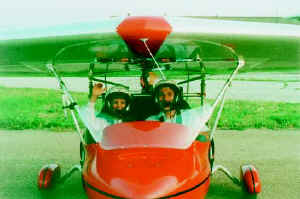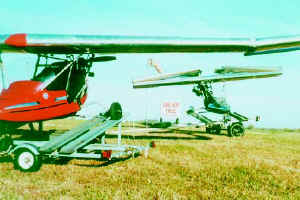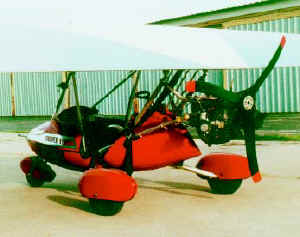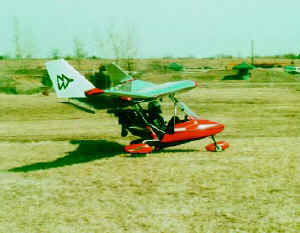A10 Mitchell
Wing, Mitchell Wing A 10 motor glider, A-10
Mitchell Wing ultralight motor glider, Mitchell Wing A 10 ultra lite
plane, Ultralight News
newsmagazine.
|
|
Single place Part 103 ultralights in the United States are defined as single
place ultralight aircraft that weigh 254 lbs or less, have a stall speed
not more than 24 knots, a top
speed of 55 knots, and carry no more than 5 gallons of fuel. To fly a
legal Part 103
ultralight aircraft in the United States the pilot does not require a
pilot license.
Single place aircraft weighing more than 254 lbs. in the U.S. require a
pilots license and must be built as experimental, amateur built,
homebuilt aircraft. These include weight shift aircraft, more commonly
known as trikes, powered parachutes, and powered para-gliders.
Single place ultralights in Canada can weigh up to 1200 lbs. and an
ultralight pilots license is required to fly them. |
|
|
|
|
Mitchell Wing A 10
ultralight, Mitchell Wing A 10 ultralight aircraft, Mitchell Wing A 10 ultra lite
plane, experimental amateur built aircraft.
|
|
Mitchell Wing A 10
by Jim Bethea
Vertical Speed
Indicator jostles briefly up to the 400 feet per minute mark... turbulence
shakes the huge, stiff metal wing above your head... rudder around gently
and caress the stick to feed in some stabilator... hold the horizon about
25 degrees... grooving around beautifully in the hunt for that thermal...
500 fpm on the VSI!... smooth!... shut down the noise-maker and listen to
the wind... still climbing, circling... airspeed pegged at 40 mph... You
hear the screech of a soaring eagle across the whispering void, welcoming
you...
"Powered glider" is a term often used to describe the
Mitchell Wing. Now the A10 version is being re-introduced as a capable
cross-country experimental and ultralight by Larry Smith, the new owner of
AmeriPlanes. |
|
|

Roomy side-by-side trainer. |
The 34 foot-long flying wing has a 16:1 glide ratio making it
a great glider. But the combination of low weight, low drag and high lift
also allows the plane to cruise at 55 mph on as little as one gallon of
fuel per hour with engines in the 18 to 30 hp range. Obviously, there is a
lot more potential in these designs than most people realize.
Larry jokingly says his company is the largest
manufacturer of all-metal flying wings in America... and the only one.
Actually, plans for the wood B10, U2 and P38 Mitchell designs are still
being sold by a former associate of Mitchell, Richard Avalon. Rights to
the A10 (designed by Steve Pattmont) and T10 (two-seat trainer) were sold
separately. These metal designs went out of production from 1994 until
last year, when Larry Smith bought AmeriPlanes and moved the company from
Kansas to new facilities in Winterset, Iowa.
Mitchell Wings are distinguished by swept-back, tapered
airfoils that are hinged in the middle for storage or trailering. Vertical
rudders stand on each tip like winglets. A pair of horizontal "stabilators"
hang beneath the outboard section trailing edges. Most notable is the lack
of a tail behind the pusher engine nor is there a canard in front. There
are no other drag-inducing protuberances or struts apart from the sleek
pointed fuselage and tricycle landing gear. The result is a true flying
wing unlike any other three-axis aircraft in the sky.
|

The most notable features of the Mitchell Wing - the lack of a tail
and unique foldable wings. |
The concept was developed by government-sponsored research
in the 1950ís. Don Mitchell was part of the team as an aeronautical
engineer. Problems with flying wings at high speeds led to the closing of
the government program, but not before Don had realized their low-speed
potential. He went on to privately design and build the B10 and other
Mitchell Wing prototypes.
Conversely, interest has renewed lately in experimenting
with flying wings. One concept is to use them as substitutes for
satellites. Eventually, huge solar-powered flying wings could be aloft for
years without landing. Others could be riding the jet streams as vast
cargo carriers the way ships sail the oceans today. Perhaps tourists will
even enjoy leisurely vacation cruises aboard luxury flying wings at the
edge of space.
In past years, altitude records have been set by Mitchell
Wing aircraft of over 27,000 feet, as well as world records for fuel
endurance and distance. One such record was set by Dick Rowley, designer
of the Rowley P-40 Warhawk replica, who flew a standard A10 over 309 miles
from Meadowlark, Colorado to Russell, Kansas for an official-FAA
straight-line unrefueled cross-country record of Category C recreational
aircraft. His enthusiastic stories about the A10 alone would more than
fill an article of this size.
The spirit of experimentation infects many individual
Mitchell Wing owners. Larry tells of one pilot making a biplane by using
the outboard sections of an A10 wing beneath the large center section.
Others have made full cockpit enclosures, changed the landing gear,
increased fuel capacity, added skis or floats and even stretched the
fuselage frame by up to twelve inches.
|
 The Mitchell
Wing displaying its exquisite design. The Mitchell
Wing displaying its exquisite design. |
Larry Smith is incorporating some of the best refinements
into his new line of Mitchell Wings. The original A10 weighs 270 pounds
and cruises at up to 70 mph with a Zenoah 22 hp engine. Larry stripped off
the fiberglass pod and wheel fairings to create a legal ultralight he
dubbed the A10B ("basic"). A deluxe version of his roomy side-by-side
trainer is the T10D, which can comfortably carry both 6 ft 250 lb Larry
and another 6 ft 2 in 180 lb pilot together.
Later this summer, he plans to introduce a totally new
aircraft of somewhat more traditional design called the M10. It will have
the same strong metal wing but with a straight leading edge, rather than
the present V-shape, and will also have a tail. One and two-seat versions
will be offered. Larry hints that, judging from the flying prototype, the
M10 will be an exceptional aircraft.
Flying characteristics of the A10, B10 and other Mitchell
Wings are similar. Unfortunately, rumors misled many to think all the
designs are too pitch sensitive and dangerous. A number of B10 tumble
accidents did occur back in the early 1980ís due to incorrect weight and
balance in a narrow CG (center-of-gravity) envelope. PIO (pilot induced
oscillation) was also a problem if a novice pilot "chased" the nose with
rapid stick movements at flight speeds above 45 mph. Considering how
radically advanced the early Mitchell Wings were for their time, it is
easy to understand how most of the accidents were a result of
inexperienced pilots trying to teach themselves how to fly.
Several of the B10 accidents were caused by stalls at
low-altitude. Stall, when forced, occurs at 27 mph, but two or three
hundred feet may be lost before recovery. The B10 also had a stick
suspended from overhead that tended to confuse pilots. The A10, however,
has much of the earlier pitch-sensitivity dampened out by more stick
travel in proportion to aileron movement, as well as by using bell-cranks
and solid push-rod connections to the control surfaces.
Another notable flight characteristic is the degree of
adverse yaw in uncoordinated turns. According to one experienced Mitchell
Wing pilot, John Rauqust, this is due to the stabilators being only three
feet aft of CG on the tail-less plane. Primary control should be with
rudders followed by very light stick input. Otherwise, the stabilators
should be moved no more than 15 degrees at a time to make smooth turns.
Regarding the rumors of dangerous instabilities, John says
the A10 Mitchell Wing is an excellent, stable airplane with outstanding
features such as being extremely stall resistant. An incident that
illustrated the A10ís in-flight stability is when he once neglected to
connect the rudder cables before taking off. He simply circled around
using the stabilators and landed normally.
|

Mitchell Wing in motion. |
Another dedicated Mitchell Wing pilot, who also happens to
be one of the most experienced hanglider, ultralight and sailplane experts
in America, is Woody Jones. He has actually flown loops and other mild
aerobatics with the A10 (but warns that the standard rudder pivots are not
stressed to the +6G strength of the wing itself). He continues to fly his
A10 over 100 hours per year even though he owns several other excellent
airplanes and has test flown many other soaring types. Modestly, he
discounts his hundreds of hours in the A10 by referring to another friend
who has over 12,000 hours on a Mitchell Wing!
Taxiing crosswind can be difficult and may even require
someone to hold a wingtip down. Ailerons (stabilators) become effective in
high-speed taxi at 28 mph but need a sensitive touch on the stick. On the
other hand, Dick Rowley has been able to make successful 180 degree taxi
turns in 40 mph gusts since the A10 does not have a tail for the wind to
act on. He also advises "tacking" against strong gusts in a zigzag
pattern. John Rauqust improved ground handling of his A10 by changing the
standard single-handle brake lever on the stick to differential braking
that tightens as he leans the stick to one side or the other.
Take-off sequence in the standard A10 involves centering
the stick at neutral, then easing it slightly forward to hold the plane on
the ground as it accelerates to flying speed. When the sheer-panel that
forms the back of the pilotís seat moves as the
weight unloads from the main wheels, return the
stick to neutral. The plane lifts off level at 35 to 40 mph after a ground
roll of 210 to 250 feet. A loaded T10 two-seater takes another 7 mph with
a roll of 275 to 300 feet. Turn-back altitude for a 180 degree turn to the
runway after an engine failure on take-off is just 125 feet. Modifications
by various owners, such as changing the angle of attack of the wing on the
ground, accounts for some wide variations from this standard take-off
performance.
Climb is 650 fpm at 40 mph, using the Zenoah G25B 22 hp
engine on the A10 and Zenoah G50D 45 hp on the T10. The A10B can also use
a 20 hp 2si engine that is a few pounds lighter for the same performance.
John says his Kawasaki 440-powered A10 climbs like a "homesick angel" and
is so comfortable that he could fall asleep in the reclining upholstered
seat if it were not so exhilarating. Like many others, John is still
obviously very much in love when he talks about the aircraft.
Flight speeds in excess of the 80 mph Vne (velocity never
exceed) have been achieved even with the little Zenoah G25B. Pitch
problems at these higher test speeds were solved by a simple windscreen
adjustment. The planes are said to be almost spin-proof due to the 6
degree dihedral of the outboard wings. This same neutral spiral stability
allows the plane to "set-up" in grooving turns that make thermaling
delightfully easy. Sink rate while gliding is 250 fpm.
Range is around 150 miles with the standard two-and-a-half
gallon fuel tank of the A10B, but a five gallon option is also available.
The T10 comes with a ten gallon tank that provides about four hours of
flight time. The tank is placed close to the center of gravity since the
changing weight of fuel during flight is enough to affect balance and
performance.
Landing requires careful attention to airspeed during the
approach. If three or four knots too fast, the Mitchell Wing will float an
extra 150 yards down the runway. If too slow then pitch authority with the
stabilators is lessened and the plane may "mush" downward at 400 fpm until
flying speed is regained. Hitting the nose gear before the main wheels
will bounce the plane lightly into the air followed by a hard touch-down.
John Rauqust installed a spring on his A10 nose-wheel to
absorb some of this bounce. His advice is to approach at 40 mph and bleed
off airspeed to 35 mph over the runway threshold. Hold it a foot off the
ground and suck the stick back until flying speed is gone. Touch down at
30 mph on the main wheels an instant before the nose. Like all other
aspects of flying a Mitchell Wing, this is not too difficult for an
experienced pilot, just different from other airplanes.
Larry Smith insists on several hours of training in a T10
with a qualified instructor before anyone, even a skilled pilot, attempts
to fly a Mitchell Wing. With its tremendous lift and low drag, the wing
must be flown all the way to landing. If an approach is too high, it is
possible to deflect both of the rudders outward (since they work in
opposite directions without cross-linking). The 20 degree aft tilt of the
big rudders angles them against the airstream to cut the glide ratio in
half. They can also be used to push a wingtip down in crosswinds.
Once on the ground, the rudders can be folded down and
pinned, then the outboard wings folded back over the inboard section. Tip
to tip and fore to aft, the plane then measures 19í6"x 8' and is ready for
storage or transport.
AmeriPlanes provides a special trailer with every kit
sold. The plane is backed up onto the trailer facing sideways then
strapped down. Reassembling to flight-readiness takes five to ten minutes
(though the record is only 90 seconds!).
The kits are sold with all critical parts assembled at the
factory. This includes the four attachment points of the outboard
sections, essential presses, and foam core in the metal wings.
The hardest step is to assemble the halves of the
fiberglass fuselage, though this is actually pretty simple and is not part
of the ultralight A10B anyway. The buyer follows a step by step video
showing how to attach the rudders, wing sections and body-frame. Building
the A10D (deluxe) by a novice takes about 100 hours (70 for an expert). A
T10D takes about 150 hours and only around 75 hours for a stripped-down
T10B.
|
The above courtesy of
http://www.ultraflight.com/issues/april99/april99page36.htm
http://home.earthlink.net/~mitchellwing/
|
|
|
|
 |
Mitchell Wing A 10
ultralight, Mitchell Wing A 10 ultralight aircraft,
Mitchell Wing A 10 ultra lite
plane, experimental amateur built aircraft.
|
|
|
|
|
|
|
|
|
|
Ultralight News Web Magazine.
You may link to these pages or print
them out for your own personal use.
No part of this
publication may be copied or distributed, transmitted, transcribed,
stored in a retrieval system, or translated into any human or computer
language, in any form or by any means, electronic, mechanical,
manual, or otherwise, without the written permission of Light Sport
Aircraft Pilot News.
By copying or paraphrasing the intellectual
property on this site, you're automatically signing a binding contract
and agreeing to be billed $10,000 payable immediately. Copyright Ultralight News. Email
|
|